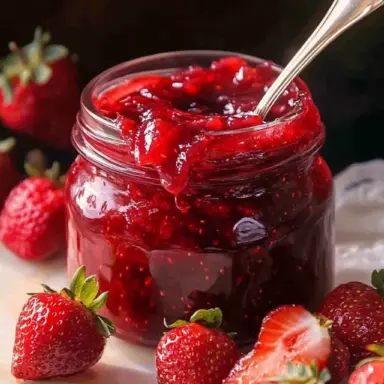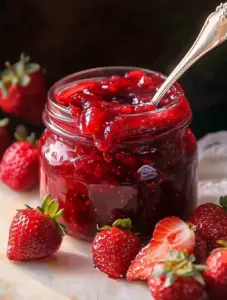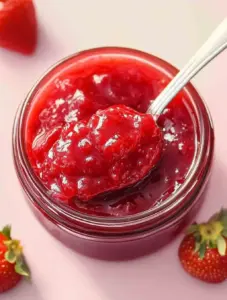Strawberry jam is a beloved spread that has captivated taste buds for centuries. Originally, people began making jam as a way to preserve fruit beyond its natural shelf life. As sugar became widely available in the 19th century, strawberries—known for their vibrant color and sweet flavor—emerged as a popular choice. This flavorful preserve quickly earned a place in kitchens around the world, bringing the essence of summer to the table throughout the year.
A Culinary Staple Across Cultures
The role of strawberry jam in culinary traditions is both historic and heartwarming. It has long symbolized hospitality, served as a thoughtful gift, and enhanced countless recipes. For instance, North Americans cherish it in the classic PB&J sandwich, while the British enjoy it with scones and clotted cream during afternoon tea. These examples highlight the jam’s versatility and enduring charm across cultures.
The Making of Strawberry Jam
Essential Ingredients
To create the perfect strawberry jam, you’ll only need a few simple ingredients—each essential to the final flavor and texture:
-
Fresh strawberries – They provide the core flavor and brilliant color.
-
Sugar – Not only does it sweeten the jam, but it also helps preserve it and balances the berries’ natural acidity.
-
Pectin – This natural substance aids in thickening the jam, giving it that desirable spreadable consistency.
-
Lemon juice – It adds brightness and helps the mixture gel properly while enhancing the fruit’s flavor.
Step-by-Step Process
-
Prepare the Strawberries
Start by washing the strawberries thoroughly. After hulling them, cut them into halves or quarters. If you prefer a smoother texture, lightly crush the berries. -
Cook the Jam
Combine the strawberries and sugar in a wide pot. Let them sit briefly so the sugar can draw out the juices. Then, stir in the lemon juice and bring everything to a boil over medium-high heat. To avoid burning, stir frequently. Once boiling, add the pectin and keep boiling until the jam reaches its setting point. -
Test for Doneness
Use the cold plate method: place a spoonful of jam on a cold plate and wait a moment. If it wrinkles when you push it, the jam is ready. Alternatively, use a thermometer—220°F (104°C) is the magic number. -
Can and Store
Sterilize jars and lids by boiling them. Carefully ladle the hot jam into jars, leaving a bit of headspace. Clean the rims, seal the jars, and process them in a boiling water bath for 10 minutes. Once cool, check the seals, label them, and store in a cool, dark place.
By following these steps, you not only preserve the season’s best fruit but also carry forward a timeless tradition.
Types of Strawberry Jam
When it comes to strawberry jam, you’ll find several varieties, each offering unique qualities:
-
Homemade vs. Store-bought: Making your own jam gives you full control over ingredients, sweetness, and texture. In contrast, store-bought options provide convenience and consistency, often ideal for those short on time.
-
Organic vs. Non-organic: Organic jam uses strawberries grown without synthetic pesticides or fertilizers, appealing to health-conscious consumers.
-
Preserves vs. Jellies: Preserves include chunks of fruit, offering a more rustic texture, whereas jellies are smooth and filtered for clarity.
These distinctions help you choose the jam that best fits your culinary needs and personal preferences.
Best Practices for Making and Storing
Making the Perfect Strawberry Jam
To ensure your jam turns out beautifully every time, begin with ripe, fragrant strawberries. These berries provide the best flavor foundation. When cooking, use a wide, shallow pan to speed up water evaporation, which helps you reach the right consistency faster.
You can also adjust sweetness and thickness depending on your preference. For example, use less sugar for a slightly tart result, or add more pectin for a firmer set. These adjustments allow you to personalize the jam to your taste.
Storing Strawberry Jam
The shelf life of homemade strawberry jam is typically one to two years when stored in a cool, dark place. Once opened, it should be refrigerated and ideally used within a month. Refrigeration vs. Pantry: Unopened jars can be stored in the pantry, but after opening, refrigeration is necessary to prevent spoilage. Signs of spoilage include mold growth, an off smell, or a change in color. Always inspect the jam before use to ensure it’s safe to consume.
Uses of Strawberry Jam
Strawberry jam is not just a spread for toast; its versatility extends far beyond. Its sweet and slightly tart flavor profile makes it an excellent ingredient in various culinary applications, from breakfast dishes to desserts and even savory pairings.
Culinary Uses of Strawberry Jam
- Breakfast dishes: Strawberry jam transforms a simple breakfast into something special. Spread it on toast, swirl it into oatmeal or yogurt, or dollop it on pancakes and waffles for a sweet start to your day.
- Desserts: It’s a star in desserts, used as a filling for cakes, cupcakes, and doughnuts, or as a topping for ice cream and cheesecakes. Its vibrant color and flavor enhance any sweet treat.
- Savory pairings: This fruit-based spread can also find its place in savory dishes. It pairs wonderfully with cheeses, especially brie and goat cheese, in appetizers. It can also be used as a glaze for meats, adding a sweet contrast to pork or chicken.
Creative Recipes with Strawberry Jam
Strawberry jam’s versatility shines in creative recipes that showcase its potential beyond traditional uses.
- Strawberry jam-filled pastries: Think beyond the classic PB&J sandwich. Use strawberry jam as a filling for croissants, turnovers, or Danish pastries, offering a sweet surprise in every bite.
- Glazes and sauces: Elevate your cooking by incorporating strawberry jam into glazes and sauces. A strawberry balsamic glaze can transform grilled chicken, while a strawberry chili sauce can add a sweet and spicy kick to wings or meatballs.
- Cocktails and beverages: Strawberry jam can be a secret ingredient in drinks, adding depth and sweetness. Mix it into lemonades, shakes, or cocktails. A strawberry jam margarita or a gin and jam cocktail can be delightful twists on classic drinks, proving that strawberry jam’s uses are only limited by one’s imagination.
Incorporating strawberry jam into various dishes can add a layer of flavor and sweetness that enhances the overall taste experience. Whether used in traditional breakfasts, innovative desserts, savory dishes, or creative beverages, strawberry jam proves to be an indispensable ingredient in the kitchen.
Health Benefits and Nutritional Information
Strawberry jam is not only delicious but also offers nutritional benefits:
- Vitamins and minerals: Rich in vitamin C and manganese.
- Antioxidants: Contains antioxidants that combat oxidative stress.
- Dietary considerations: Can be made with natural sweeteners for a healthier option.
However, it’s important to consume in moderation due to its sugar content. For more on the health benefits of strawberries, Healthline provides detailed information.
FAQs
Can strawberry jam go bad?
- Yes, strawberry jam can go bad, especially if not stored properly. Signs of spoilage include mold growth, an off smell, or a change in color. To maximize shelf life, store unopened jam in a cool, dark place and refrigerate after opening.
How can I make strawberry jam without pectin?
- Making strawberry jam without pectin is possible and often involves using more sugar and cooking the jam longer to achieve the desired thickness. Lemon juice can be a natural alternative to pectin, as it contains natural pectin and helps the jam set.
What are the best strawberries for making jam?
- The best strawberries for making jam are ripe, flavorful, and fragrant. Look for berries that are deep red, without white shoulders, which indicate full ripeness and maximum sweetness. Avoid overly large strawberries, as they can be watery.
How do I fix runny strawberry jam?
- To fix runny strawberry jam, you can re-cook it. Add a little more pectin as you do, following the product’s instructions for the amount. Another method is to simmer the jam for a longer period, allowing more water to evaporate, which naturally thickens the mixture. Always test for doneness using the cold plate method or a thermometer to ensure the jam has reached the correct setting point.
Strawberry jam is a delightful addition to any kitchen, offering a taste of sweetness and nostalgia. Whether you prefer making your own or picking up a jar from the store, it’s a versatile spread that enhances a wide range of dishes. Enjoy the process of exploring different recipes and finding your perfect jam match.

Classic Homemade Strawberry Jam Recipe
Equipment
- Large heavy-bottomed pot
- Wooden spoon
- Ladle
- Canning jars with lids and bands
- Jar lifter
- Canning funnel
- Water bath canner (optional)
Ingredients
- 2 pounds fresh strawberries hulled and halved
- 4 cups granulated sugar
- 1/4 cup lemon juice
- 1 packet about 2 tablespoons pectin (optional)
Instructions
- Prepare the Strawberries: In a large bowl, mash the strawberries to your desired consistency.
- Cook: Transfer the mashed strawberries to a heavy-bottomed pot. Add the sugar and lemon juice, stirring over low heat until the sugar dissolves. Increase the heat to high, bring the mixture to a full rolling boil, then add pectin if using. Boil for 10 minutes, stirring frequently.
- Test for Doneness: Perform the gel test by placing a small amount of jam on a cold plate. If it gels, it's ready. If not, continue cooking for a few more minutes and test again.
- Can: Ladle the jam into sterilized jars, leaving 1/4 inch headspace. Wipe the rims, apply the lids and bands, and process in a boiling water bath for 10 minutes.
- Cool: Remove the jars from the water and let cool. Check seals, label, and store in a cool, dark place.
Notes
- Pectin: Adding pectin is optional but helps ensure the jam sets properly. If you prefer a more natural set, you can omit it and cook the jam longer.
- Storage: Unopened jam can last up to two years in a cool, dark place. Once opened, refrigerate and use within a month.
- Sugar Adjustment: You can adjust the sugar based on the sweetness of your strawberries and personal preference. However, reducing sugar may affect the jam's preservation quality.
- Lemon Juice: Fresh lemon juice is preferred for its flavor and natural pectin content, which aids in setting the jam.



